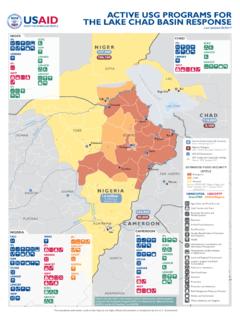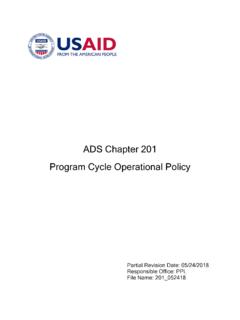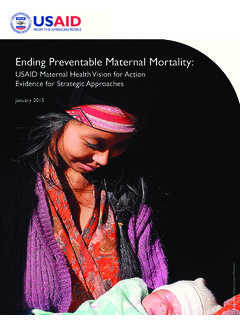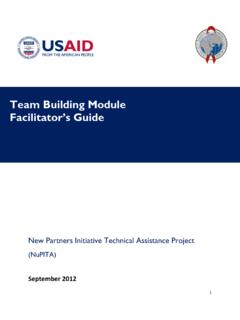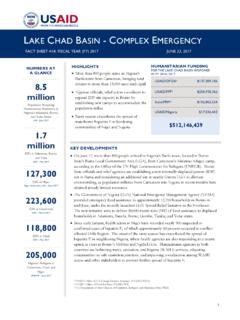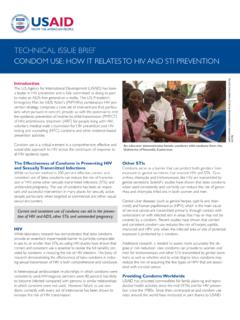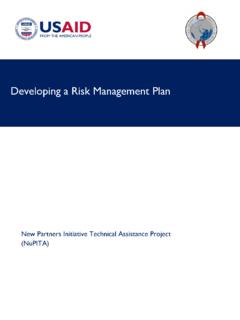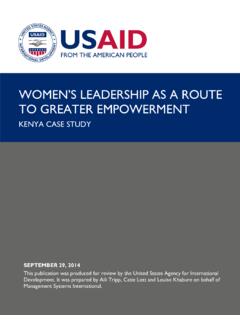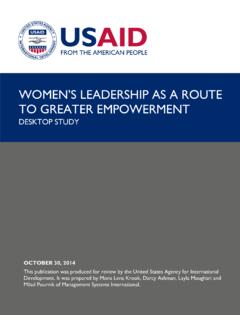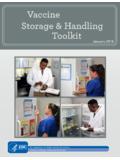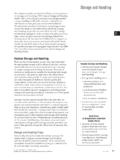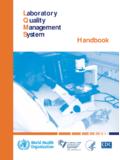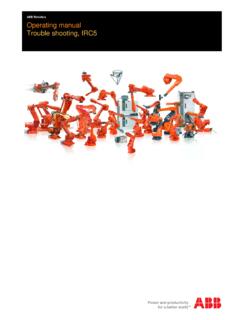Transcription of Toolkit for Monitoring and Evaluating GBV Interventions ...
1 9 May 2014 This publication was produced for review by the United States Agency for International Development. It was prepared by Jessica Menon, Victoria Rames, and Patricia T. Morris, PhD, of Development and Training FOR Monitoring AND Evaluating GENDER-BASED VIOLENCE Interventions ALONG THE RELIEF TO DEVELOPMENT CONTINUUM This document is available online. Online documents can be found on USAID s website at and the USAID Learning Lab at Documents are also available through the Development Experience Clearinghouse ( ) and on the dTS website at Prepared for the United States Agency for International Development, USAID Contract Number AID-OAA-I-10-00014-TO-2-00051. Implemented by: Development & Training Services, Inc. (dTS) 4600 North Fairfax Drive, Suite 402 Arlington, VA 22203 Phone: +1 703-465-9388 Fax: +1 703-465-9344 Toolkit for Monitoring and Evaluating Gender-Based Violence Interventions along the Relief to Development Continuum 9 May 2014 DISCLAIMER The authors views expressed in this publication do not necessarily reflect those of the United States Agency for International Development or the United States Government.
2 Toolkit for M&E of GBV Interventions along the RDC Acknowledgments The development of the Monitoring and Evaluation (M&E) Toolkit was made possible through the generosity of the United States Agency for International Development (USAID). It was prepared through the Transparency, Accountability and Performance Indefinite Quantity Contract (TAP IQC), Gender-Based Violence Strategy Research Agenda Project. Development and Training Services, Inc. (dTS) fielded a three-person team: Jessica Menon (independent consultant), Patricia T. Morris, PhD (director, Gender Practice at dTS), and Victoria Rames (independent consultant) to develop the Toolkit . Peter Pawlak, an independent consultant working through Chemonics, participated in the fieldwork that formed the basis of the Toolkit . Staff at dTS Alex Ginn, Ashley Mills, and Dawn Traut, and dTS interns Payal Chandiramani, Aicha Cooper, and Megan Sullivan contributed time and effort in the development of the Toolkit .
3 The Toolkit is the result of a collaborative learning process that took place from December 2012 to November 2013. USAID staff based in Washington, DC, including Misrak Brhane, Tiare Cross, Niloufer De Silva, Carolyne Siganda, and Kelli Young, provided leadership and technical guidance during all stages of the Toolkit s development. The research team further thanks Niloufer De Silva and Tiare Cross for drafting select sections of the Toolkit . The USAID country mission staff, including Katherine Reniers and Nettie Jannini (Haiti), Passanna Gunasekera (Sri Lanka), and Betty Mugo and Monica McQueary Azimi (Kenya), shared their firsthand experience on the M&E of gender-based violence (GBV) Interventions along the relief to development continuum during the research team s field missions in March July 2013. They also organized focus groups and meetings with staff of USAID implementing partners, United Nations (UN) agencies, and other national and international nongovernmental and community-based organizations, as well as with beneficiaries of select GBV programs, in Haiti, Sri Lanka, and Kenya.
4 Through these consultations, the research team gathered data and insight into the M&E for GBV Interventions , which ultimately informed and shaped the Toolkit . The research team also benefitted enormously from the opportunity to learn from GBV project/ program beneficiaries, women and men, in Haiti, Sri Lanka, and Kenya. They shared their views on what they perceived to be the most important changes that the GBV programming had made in their lives. The research team extends its appreciation for field test inputs received in July 2013 from representatives at United Nations Children s Fund, UN Women, Gender-Based Violence Recovery Centre, International Rescue Committee (IRC), Federation of Women Lawyers Kenya (FIDA), Coalition on Violence Against Women (COVAW), National Gender Equality Commission (Kenya), MSF-France, No Means No Worldwide, Population Council, Neighborhood Alliance Initiative, Liverpool Voluntary Counseling and Testing (LVCT), PSI/Pathfinder, Femnet, and Aphia-Pathfinder.
5 The research team is also grateful to the IRC/Peace Initiative Kenya and its local implementing partners COVAW, FIDA, and Rural Women Peace Link for their valuable technical guidance and contribution of staff resources and time in the field-testing of the Toolkit . The research team appreciates the feedback received on the first draft of the Toolkit from implementing partners and USAID staff in the field, including Passanna Gunasekera (USAID/Sri Lanka) and Kathy Kantengwa, MD, MPA (MSH/Haiti). Lastly, the research team thanks independent consultants and GBV experts Jeanne Ward and Julie Lafreniere, Christine Heckman of the Inter-Agency Standing Committee (IASC) GBV Area of Responsibility Rapid Response Team, and Samira Sami, Health Scientist at the US Centers for Disease Control and Prevention for their enormous support and technical guidance during the development of the Toolkit .
6 Toolkit for M&E of GBV Interventions along the RDC i CONTENTS ACRONYMS .. iv INTRODUCTION .. 1 BACKGROUND .. 1 Toolkit PURPOSE AND OBJECTIVES .. 2 Toolkit AUDIENCE .. 3 Toolkit USE .. 3 Toolkit 5 1. GUIDING PRINCIPLES FOR GBV ALONG THE RDC .. 7 DEFINING PHASES ALONG THE RDC .. 7 GENERAL FRAMEWORK .. 8 GUIDING PRINCIPLES: WORKING WITH SURVIVORS OF GBV .. 11 GUIDING PRINCIPLES: PLANNING, COLLECTION, AND USE OF INFORMATION ON GBV .. 12 USING INTERNATIONALLY AND NATIONALLY RECOGNIZED DEFINITIONS .. 13 2. PLANNING FOR M&E .. 14 IDENTIFY AND ENGAGE KEY STAKEHOLDERS .. 14 DEVELOP OR MODIFY A TOC .. 17 CONDUCT, ANALYZE, AND INTERPRET SITUATIONAL/NEEDS ASSESSMENT DATA .. 19 PREPARE THE LOGICAL FRAMEWORK WITH INDICATORS .. 24 PREPARE THE M&E PLAN IN ADVANCE .. 32 PREPARE THE PERFORMANCE INDICATOR REFERENCE SHEETS.
7 46 GATHER BASELINE DATA .. 48 3. IMPLEMENTING THE M&E PLAN .. 55 COLLECT Monitoring DATA .. 55 MONITOR FOR PROGRAM QUALITY .. 60 MONITOR FOR DATA QUALITY .. 61 CONDUCT REAL-TIME, MIDTERM, AND FINAL EVALUATIONS .. 63 4. USING M&E 69 GBV APPROACHES TO SHARING M&E INFORMATION .. 69 GBV PROJECT USES OF M&E FINDINGS .. 70 SHARE GBV INFORMATION WITH NATIONAL AND INTERNATIONAL STAKEHOLDERS .. 73 USAID-WIDE USES OF INFORMATION .. 79 ANNEX A: STAKEHOLDER ANALYSIS TOOL .. 81 ANNEX B: DFID GBV THEORY OF CHANGE .. 83 ANNEX C: DATA SOURCES MATRIX FOR CONDUCTING GBV SITUATIONAL/NEEDS ASSESSMENT, PERFORMANCE Monitoring , AND EVALUATION .. 84 ANNEX D: DATA COLLECTION TOOL .. 98 ANNEX E: LOGICAL FRAMEWORK MATRIX .. 110 Toolkit for M&E of GBV Interventions along the RDC ii ANNEX F: THE GBV INDICATOR 114 ANNEX G: PERFORMANCE Monitoring COMPONENT OF THE M&E PLAN.
8 116 ANNEX H: USAID/OFDA SAMPLE PERFORMANCE Monitoring PLAN .. 120 ANNEX I: DATA QUALITY ASSESSMENT CHECKLIST AND RECOMMENDED procedures 122 ANNEX J: PERFORMANCE INDICATORS REFERENCE SHEETS (PIRS) FOR GBV PROGRAMMING .. 127 ANNEX K: IFRC PROJECT/PROGRAM INDICATOR TRACKING TABLE (ITT) .. 173 ANNEX L: EVALUATION COMPONENT OF THE M&E PLAN .. 179 ANNEX M: BUDGET CONSIDERATIONS FOR THE M&E PLAN .. 181 ANNEX N: CATHOLIC RELIEF SERVICES BUDGETING FOR M&E IN AN EMERGENCY .. 184 ANNEX O: OVERVIEW OF THE GBVIMS .. 185 ANNEX P: SAFETY AUDIT TOOL .. 187 ANNEX Q: FOCUS GROUP GUIDE .. 189 ANNEX R: COMMUNITY MAPPING .. 198 ANNEX S: GENERAL KEY INFORMANT INTERVIEW GUIDE .. 202 ANNEX T: GUIDANCE FOR OBTAINING INFORMED AND VOLUNTARY CONSENT .. 206 ANNEX U: USAID CHECKLIST FOR REVIEWING SCOPES OF WORK FOR PERFORMANCE EVALUATIONS .. 211 ANNEX V: EVALUATION REPORT TEMPLATE.
9 218 ANNEX W: ELEMENTS IN USAID S AND USAID/OFDA S GBV M&E PLANS .. 222 ANNEX Y: RESOURCES TO ASSIST PRACTITIONERS .. 223 Toolkit for M&E of GBV Interventions along the RDC iii FIGURES Figure 1. Process for M&E of GBV Intervention .. 4 Figure 2. Core Approaches to GBV Programming and M&E .. 9 Figure 3. Process for Planning M&E .. 14 Figure 4. Illustrative List of Stakeholders to Engage Throughout GBV Program and M&E Planning, Design, and Implementation .. 16 Figure 5. Illustrative Example of Writing a GBV Objective Statement .. 25 Figure 6. Outcomes, Outputs, and Inputs .. 27 Figure 7. Example of Varying Activities along the RDC to Achieve Similar Output .. 30 Figure 8. Examples of GBV Programming Assumptions in a Logical Framework Matrix .. 31 Figure 9. USAID Definitions of Performance Monitoring and Evaluation .. 32 Figure 10.
10 Performance Evaluation Plans and Impact Evaluation Plans .. 35 Figure 11. Main Elements of the SoW for the Evaluation .. 41 Figure 12. USAID M&E Plan Budget Components .. 43 Figure 13. Considerations for Selecting Staff and Engaging Stakeholders in Conducting M&E .. 45 Figure 14. Ethical Considerations in Selecting and Adapting Data Collection Tools .. 57 Figure 15. Using Monitoring and Evaluation and Research-Based Evidence to Improve, Scale-Up, and Institutionalize GBV Programs for Governments and NGOs .. 76 TABLES Table 1. Definitions along the RDC of Crisis Phases, Linkages, and Mutual Interests between Humanitarian and Development Actors .. 8 Table 2. Advantages and Disadvantages of Participatory M&E .. 10 Table 3. Definitions and Examples of Threats, Vulnerabilities, and Capacities .. 22 Table 4. USG Standard Foreign Assistance Gender Indicators.
